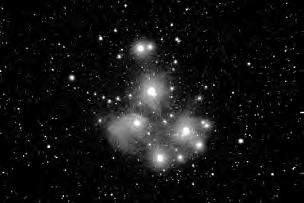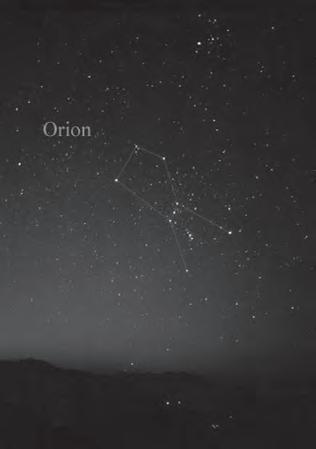
3 minute read
Our Winter Skies
article and photos by Randy Hodges
Our yearly orbit around the Sun means that our evening skies face a different part of the sky each season. During the summer, our evening skies are facing the center of the Milky Way. The summer Milky Way is magnificent and is clearly visible from dark sites. Winter has us facing the opposite direction, looking away from the galactic core. Astronomers often call the winter skies the “Orion Season” because one of the most iconic constellations dominates the skies.
Advertisement
Orion is second only to the “Big Dipper” as the most readily recognized pattern of stars. It depicts a hunter facing the bull in the constellations: Taurus with his dogs at his heels. The story we are most familiar with is from the Greco-Roman world. Orion claimed that he would kill all the animals on Earth. The god Gaia decided to kill him with a scorpion. Another god, Ophiuchus, the Serpent Bearer, revived him with an antidote. Thus, the constellation Scorpius is on the opposite side of the Sun from Orion and the two are never visible at the same time. Many other cultures had stories about Orion. The constellation was mentioned in the Bible three times.
It is a remarkable constellation with many fine stars and nebulae. There are seven bright stars with names.
Betelgeuse is near Orion’s head. It is a huge, old, cool red star. It is about 548 light years away, which means that the light we see now left there about the time Columbus was leaving for the new world. Scientists think it is near the end of its life cycle and that it will end its life in a supernova explosion relatively soon. Soon, in astronomical terms, is defined as some time in the next five to fifty thousand years.
The star Rigel is near Orion’s foot. It is very different than Betelgeuse, being extremely hot, blue, and relatively young. Stars like Rigel live relatively short lives as they go through their fuel quickly. A good analogy is a campfire. A big campfire gets very hot but uses up its fuel quickly.

The star Bellatrix, like Rigel is a very hot blue star located in Orion’s right shoulder.
Three bright stars make up the belt around Orion’s waist. A dimmer group of stars descend from the belt’s left side and make up his sword. The center star of the sword is the famous “Orion Nebula” which is one of the few naked eye nebulas. It takes up an area of about twice the size of the full Moon. It is a “Stellar Nursery” where gas and dust are coalescing into new young stars. The “Horsehead” and “Flame” Nebulae are near the right-hand star of the belt. The horsehead is created by dark dust that is silhouetted against the bright glowing hydrogen gas in this area.
Orion faces the constellation Taurus. If you follow the belt of Orion to the right, you will come to a group of stars in a “V” shape. That is the head of the bull. The tip of the “V” on the left is the star Aldebaran which is also a cool giant star. The group of stars to the right of Aldebaran are called the Pleiades or “The Seven Sisters.” The Japanese call this group of stars “Subaru.” If you own a Subaru automobile this group of stars is on the emblem on the back of your car.
If you follow Orion’s belt to the left, you will come to the star Sirius also known as the “Dog Star” which is the brightest star in our sky. It is a young hot blue star. It is so bright because it is close to us, only about 8.6 light years away. It is the brightest star in one of Orion’s hunting dogs.

The winter sky has many other wonders for both your eyes and telescopes. Come visit the Community Observatory and we will introduce you. The observatory is open on Friday and Saturday evenings from 7:30-9:30 during the winter.
Winter is not my favorite season. In fact, it's not my 2nd or 3rd pick either. I do love the part of winter though that includes the warmth of lights and fireplaces, cozy afternoons with hot cocoa and a book, and I won't shy away from a fun trip to the snow, but that's pretty close to where my love stops.
This issue of Around Here Magazine is brimming with warmth and winter, perfect for a hot cocoa afternoon. "What's Overhead" will inspire you to bundle up on a clear night, crisp air on your cheeks and nose, and take in the constellations above. Talk of quilts ("Women Making History") will make you feel cozy and "Mediterranean Climate Gardening" will remind you of warmer days.
Winter is often a difficult time of year: shorter, darker days that we know will eventually yield to longer and brighter days.
Many of the articles this issue also remind us to connect to those around us as a community. "Wine Times" encourages us to get together and get out, the recipes are meant to be shared, there are several community events meant to connect and support each other, and stories that show human (and dog!) connection and its positive impact. So grab your hot cocoa, settle in and enjoy this issue of Around Here.
See you in Spring!








